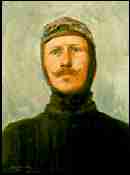
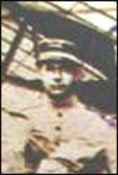
1874-1915 |
 |
 |
|
From Força Aérea Brasileira website |
Collection of Paulo Ramos Derengoski |
|
|
 |
|
Collection of Paulo Ramos Derengoski Da esquerda para a direita: Dr. Urbano, Tenente Antônio Guilhon, Coronel Fabriciano, Tenente Rego Barros, Capitão José Ozório, Capitão Oscar Paiva, Tenente Ricardo Kirk (aviador), Tenente Daltro Filho, General Setembrino de Carvalho, Tenente Euclides Figueiredo, Capitão Souza Reis, Ernesto Darioli (aviador), Tenente João Niemeyer. |
|
Reportagem Especial Autor: Ivan Castilho Data: 04/08/2002 "Li certa vez numa questão de vestibular, sobre a primeira utilização do avião para fins militares, que havia sido na Guerra do Contestado no interior de meu estado, Santa Catarina. Como piloto virtual, tal fato me intrigou. Passaram-se os anos e no dia 14 de julho último, vejo no jornal uma foto deste avião e um comentário de sua utilização. De imediato, entro em contato com senhor Paulo Ramos Derengoski, em Lages, pois fôra ele quem havia cedido a foto para ser publicada, e que novamente, cedeu para que eu pudesse contar esta história. O Sr. Paulo também me recomendou a leitura do livro A AVIAÇÃO MILITAR NO CONTESTADO - REQUIEM PARA KIRK, de autoria do historiador Nilson Thomé, impresso pela 83 pg, 1985. Consegui obter o livro na biblioteca da Universidade Federal de Santa Catarina, e depois de uma emocionante leitura e re-leitura, pude tentar resumir nestas poucas linhas a história que levou anos para ser escrita, conforme relato do autor." English Translation Special Report Author: Ivan Castilho Date: 04/08/2002 "I read one time in a college entrance exam, on the first use of the airplane for military ends, which had been in the Guerra do Contestado, (War of the Contested one), in the interior of my state, Santa Catarina. As a virtual pilot, such a fact intrigued me. The years had passed and on the 14th of last July, I saw a photo of the aeroplane in the daily newspaper, Diário Catarinense, and a commentary on its use. Immediately, I entered into contact with Mr. Paulo Ramos Derengoski, of Lages, for it was he who had offered the photo to be published, and subsequently he granted me permission to use it so that I could retell the story. Mr. Derengoski also recommended that I should read the book A AVIAÇÃO MILITAR NO CONTESTADO - REQUIEM PARA KIRK, written by the historian Nilson Thomé, published by the Fundação Educacional, (Educational Foundation), of Alto Vale do Rio do Peixe,83 pg, 1985. I managed to get a copy of the book in the library of the Universidade Federal de Santa Catarina, and after an emotional reading and re-reading, I decided to try to summarize in these few lines the history that took years to be written, according to the story of the author." This is a very useful article for anyone wanting to understand the importance of Lt. Kirk in the development of aviation in Brazil. Ivan Castilho has summarized six chapters from the book and offers a fascinating introduction to the story. It is written in Portuguese and is one of several reports which can be found on the Aerovirtual website. If you need an English translation, it is available directly from the entry on Google. You can reach it by clicking on the English title above. |
|
While on the website, you will be rewarded by taking advantage of the many other sections. |
Of Returning to Brazil, he was active as Managing Technician of the Brazilian Flying club, hoping to create a propitious environment to the development of aviation. Having gained a popular subscription for the purchase of airplanes for the Brazilian Flying club, Lieutenant Kirk received from the Directors of the Club the authorization to go to the Europe to acquire two airplanes; on April 6, 1914, he arrived again in Brazil, on the steamship "Araguaia", bringing the aerial material. On May 24, 1914, in order to awaken the enthusiasm of the public for aviation, a speed contest between two airplanes was scheduled: A French Morane Saulnier monoplane, with a wing area of 16 square meters, powered by a Le Rhône engine of 80 H.P. and piloted by Lieutenant Ricardo Kirk. An Italian Bleriot-Sit monoplane , with a wing area of 16 square meters, powered by a Gnome engine of 80 H.P. and piloted by the civilian aviator Ernesto Darioli. |
|
The start was from the Field of the Alfonsos and the route was designed so that the planes passed
over several parts of the city. On the return, an accurate landing was required such that the planes had to finish as close as possible to a circle, six meters in diameter, drawn on the field. Darioli had to abandon the race due to the overheating of the motor of his airplane. Lieutenant Kirk completed the entire circuit and was declared to be the winner. IN MILITARY OPERATIONS IN BRAZIL General Setembrino de Carvalho was in charge of the military operations of the government forces. The selections below, excerpted from one of his reports, mentions some of his preparatory steps. In order to facilitate the use of airplanes, in the course of the operations, the airplanes had to be moved by train, from Rio De Janeiro to the border of Santa Catarina. |
|
" But it was necessary to recognize, it was necessary above all, to identify the position of the
redoubts, an easy operation for trained and brave aviators. I remembered the School of Aviation and Lieutenant Ricardo Kirk,
who would take the responsibility to iniciate the important task of aerial reconnaisance. I asked the the approval of the Minister (16 of September of 1914), explaining to him the reasons, and three days later I received his telegram, granting to me the services of that officer, along with all necessary material to perform the task that might be required. There was, during the trip, an unfortunate fire caused by sparks from the locomotive which had rendered one aeroplane unusable and damaged the other. Lieutenant Kirk, after choosing fields appropriate to advance, in Black River, Canoinhas and União da Vitória , returned to the River to search more two monoplanes and the supplies that were needed for repairing the damaged plane. However, before undertaking the trip, he began, with my approval, the construction of hangars in União da Vitória and personally directed the construction of the three airfields. |
|
In February of 1915, the main operations were being executed by the South Column, moving from
south to the north. They attacked the rebel force, already concentrated in their redoubt in the valley of the Santa Maria River. Three monoplanes were attached to the União da Vitória airfield, under the command of Lieutenant Ricardo Kirk. The other aviator was the civilian Ernesto Darioli. These three aeroplanes, in addition to the one which was destroyed in the railroad car fire, between Rio De Janeiro and the União da Vitória city, comprised the flotilla of " the Brazilian School of Aviation ", which had already served at the Campo dos Afonsos, (Field of the Afonsos), in 1914, or were loaned by the Aeroclube Brasileiro. (Brazilian Flying Club). The anticipated mission of the airplanes was to make reconnaisance flights over the enemy positions and to help control Artillery fire. To allow easy access of the airplanes to the area of operations, two more airfields had been constructed, one at the "Rio Caçador" railroad station and another one on the Fazenda Claudiano, (Claudiano Farm) more to the east of this last field, next to the Command Headquarters of the Column of the South. Lieutenant Kirk intended to take off, and operate in the area of the Saint Maria Redoubt. Because the field of the Claudiano Farm was well hidden in the middle of a pine tree plantation, they attached large sheets of cloth to the tops of three pines, to designate the position of the airfield. Lieutenant Kirk died on the eve of the day when the decisive attack against the redoubt was carried out. On page 253 of the book "A Campanha do Contestado", (The Campaign of the Contested one), written by Herculano Lieutenant Teixeira de Assunção, who participated in the operations, is found the following story: " At 18 hours the sad report arrived to the attention of Commander Estillac : - that 1º Lieutenant Ricardo Kirk had been the victim of a disaster, when the União da Vitória-Rio Caçador-Claudiano flight had just begun. The military pilot, who flew his aeroplane with such great skill, began a beautiful flight from União da Vitória on 1º of March of 1915. However, only 1 km from the Rio Jangada, at kilometer 42 of the Palmas road, an unexpected incident caused the aeroplane to fall to earth, killing the fearless aviator. " The Brazilian Army thus lost, at a critical time in the development of aviation, its very best aviator. Kirk had learned to fly in Europe only two years earlier, and was endowed with long experience. According to the testimony of his military contemporaries, he was an officer of great capacity and had unwavering faith in the future of Aviation. In October of 1943, the mortal remains of Lieutenant Kirk were transferred to the Mausoléu do Aviadores, (Mausoleum of Aviators), in the João Batista cemetary in Rio De Janeiro. Lieutenant Kirk was born in the city of De Campos, Rio De Janeiro, in 1874. He enrolled in Military School in 1891, was promoted to Second Lieutenant in November of 1893 and Primeiro-Tenente, (First Lieutenant), in March of 1898. On the north-east corner of Campo dos Afonsos, (Afonsos Field), there is a hill named for Ricardo Kirk, in homage to that brave pioneer of Military Aviation. The hill as viewed today is very diminished as a result of substantial razings. |
|
|
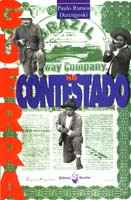 |
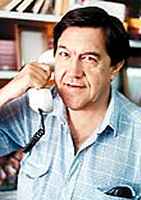 |
from Editora Papel Virtual |
from Editora Papel Virtual |
|
Contestado, uma guerra catarinense O jornalista lageano Paulo Ramos Derengoski estava na França, nos anos 80, quando pela primeira vez ouviu falar da Guerra do Contestado. Nascido no planalto sul catarinense, Derengoski estranhou o fato de desconhecer totalmente esta revolta popular ocorrida há menos de um século em região bem próxima à sua cidade natal. De volta ao país, começou a investigar o assunto. Durante anos entrevistou pessoas e coletou fotos e objetos da época. "Guerra no Contestado" é o quarto livro publicado por Derengoski sobre o assunto. Antes ele já havia publicado "O desmoronamento do mundo jagunço", "Os rebeldes do Contestado" e"Os cavaleiros do fim do mundo". Terceiro livro de Derengoski sobre o Contestado, "Os cavaleiros do fim do mundo" também ganhou uma edição digital, disponível na Editora Papel Virtual . Contestado, uma guerra catarinense The lageano journalist Paulo Ramos Derengoski was in France, in the 80's, when for the first time he heard of the Guerra do Contestado. Having been born in the catarinense south plateaus, Derengoski found it odd that he hadn't heard of this popular revolt which had occurred less than a century ago in the region next to his native city. Upon returning to his country, he started to investigate the subject. During the following years he interviewed people and collected photos and memorabilia of the epoch. Guerra do Contestado is the fourth book published by Derengoski on the subject. He had already had published "O desmoronamento do mundo jagunço", "Os rebeldes do Contestado" e"Os cavaleiros do fim do mundo". The third book Derengoski wrote on the Contestado, "Os cavaleiros do fim do mundo" is also available in a digital edition from Editora Papel Virtual . Editor's Note: These books are written in Portuguese and may be obtained from several online sources. |
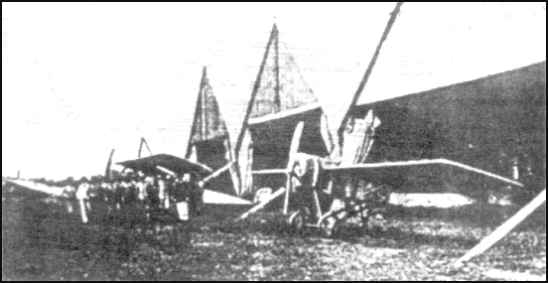 |
|
|
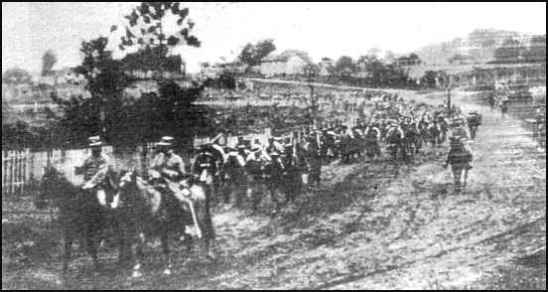 |
|
In 1914, a legalist column crosses the backcountry of the Catarinense plateau to give battle to the
rebels of the Contested one |
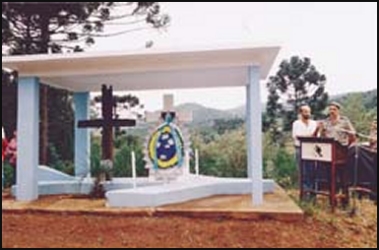 |
|
The photo above shows the monument which was erected close to the site of the accident
which was near the edge of the Jangada River on land now belonging to the city of General Carneiro, Pr. In October of 1943, the mortal remains of Lieutenant Kirk were transferred to the Mausoléu do Aviadores, (Mausoleum of Aviators), in the João Batista cemetery in Rio De Janeiro. |
|
If you have any information on this Early Bird, please contact me. E-mail to Ralph Cooper Back 

|